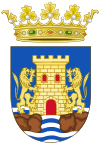Chiclana de la Frontera
| Chiclana de la Frontera | |||
|---|---|---|---|
| Municipality | |||

|
|||
|
|||
| Location in Andalusia | |||
| Coordinates: 36°25′N 6°9′W / 36.417°N 6.150°WCoordinates: 36°25′N 6°9′W / 36.417°N 6.150°W | |||
| Country |
|
||
| Autonomous community |
|
||
| Province | Cádiz | ||
| Comarca | Bay of Cádiz | ||
| Commonwealth | Municipios de la Bahía de Cádiz | ||
| Founded | 15 May 1303 | ||
| Government | |||
| • Mayor | Ernesto Marín (PP) | ||
| Area | |||
| • Total | 205.45 km2 (79.32 sq mi) | ||
| Elevation | 11 m (36 ft) | ||
| Population (2015) | |||
| • Total | 84,201 | ||
| • Density | 410/km2 (1,100/sq mi) | ||
| Demonym(s) | Chiclaneros | ||
| Time zone | CET (UTC+1) | ||
| • Summer (DST) | CEST (UTC+2) | ||
| Postal code | 11130 | ||
| Dialing code | 956 | ||
| Website | Official website | ||
Chiclana de la Frontera is a town and municipality in southwestern Spain, in the province of Cádiz,Andalusia, near the Gulf of Cádiz. It belongs to the association of municipalities of the Bay of Cádiz (Bahía de Cádiz), the provincial capital of Cádiz, Jerez de la Frontera, San Fernando, El Puerto de Santa María, Puerto Real and Rota which form the third largest metropolitan area in Andalusia, behind Seville and Málaga, and the twelfth largest in Spain. It is located 20 kilometres (12 miles) south-east from Cádiz, and borders the municipalities of San Fernando and Puerto Real to the north. In 1877, the municipality's population was 11,677; in 2012, it was 81,473. It has a surface area is 203 square kilometres (78 sq mi) and a population density of 401 inhabitants / km². The average elevation is 11 metres (36 ft) above sea level. The economy depends largely upon modern industry, especially salt processing and tourism, and the municipality is known for its beaches such as the 6 kilometres (3.7 mi) long Playa de la Barrosa, hotels and golf courses in the resort of Novo Sancti Petri. The municipality contains the largest number of hotel beds in the Province of Cádiz and the Costa de la Luz. The town's newspaper, Chiclana Información, is distributed on Saturday mornings.
Human presence in the area dates back to Paleolithic times. Several Neolithic era villages have been unearthed in the area including that of La Mesa. During the 1st century, the Phoenicians settled near the town, particularly in the small island, Islote de Sancti Petri, founding a temple dedicated to their God, Melqart. When the Romans arrived they dedicated the temple to Hercules. A marble statue of a Roman emperor deified during the 2nd century was found in the waters of Sancti Petri in 1905. A ancient stronghold of the Phoenicians, remains from the Phoenicians, Carthaginians and Romans unearthed in Chiclana are in the Museum of Cádiz.
...
Wikipedia



